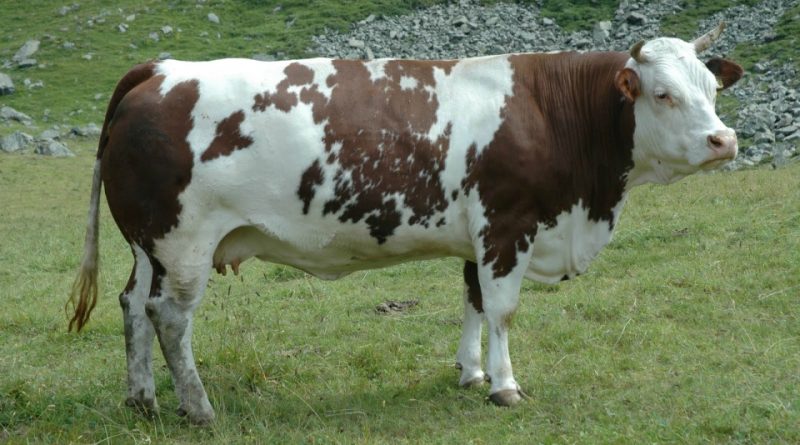Red Pied Valdostana
Red Pied Valdostana
The Red Pied Valdostana is an Italian bovine breed (Bos taurus Linnaeus, 1758) originating from the Valle d’Aosta, with a dual aptitude especially for the production of milk.
Systematics –
From a systematic point of view, it belongs to the Eukaryota Domain, Animalia Kingdom, Subgenus Eumetazoa, Superphylum Deuterostomia, Phylum Chordata, Subphylum Vertebrata, Infraphylum Gnathostomata, Superclass Tetrapoda, Class Mammalia, Subclass Theria, Infraclasse Eutheria, Superorder, Laurasiatheria, Clade Ungulata, Order Artiodactyla, Suborder Ruminantia, Infraordine Sheep, Family Bovidae, Subfamily Bovinae and then to the Genus Bos, to the Taurus Species and to the Red Pied Valdostana.
Geographical and area distribution –
The Red Pied Valdostana which is known in French as Valdostaine pie rouge is an autochthonous bovine breed of the Valle D’Aosta which is the Italian region where almost all of its heads are bred (about 85%) and for most of the rest in areas contiguous.
Origins and History –
The Red Pied Valdostana is a bovine breed that belongs to the branch of the mountain red pezzate and is part of the original population of the south-eastern branch of the Alpine arc. His studbook was inaugurated in 1985. At the 2002 census the number of animals was 14,200, of which 409 were breeding bulls.
The Red Pied Valdostana is part of the group of three breeds that differ in their morphological characteristics, mantle, milk and meat production and temperament. These breeds are: the Valdostana Pezzata Rossa, the Valdostana Pezzata Nera and the Castana.
This breed derives, like the Simmental, from the cattle of the Northern European pezzate that was introduced in Italy by the Burgundians towards the end of the fifth century. Later these populations adapted to the particular environmental conditions.
The Red Pied Valdostana is one of the 11 breeds that adhere to the European Federation of Alpine System breeds.
The subjects of these breeds are enrolled in the 2 Genealogical Books; in one only the subjects of the Valdostana Pezzata Rossa race are entered and in the other both the subjects of the Valdostana Pezzata Nera and those of the Castana breed. The National Association of Bovine Breeders of the Valdostana breed (A.N.A. Bo.Ra.Va.) was founded in 1937.
It should also be remembered that a sub-race of the red spotted Valdostana is the Razzeta d’Oropa.
Morphology –
This breed is recognized for having a deep red coat, tending to violet, with light spots that somewhat recalls the characters of the Swiss Evolène breed with which it has a noticeable inbreeding. The head is white with red ears; rarely there are red spots on the head. Ventral limbs and arts are generally white.
The muzzle is rosy, the horns are short and thick, with a waxy yellow color like the hoofs.
It is a medium-sized breed, with a height at the withers of 130 cm for a weight of 500 kg for cows and 135 cm for 650 kg for bulls.
They are therefore animals with a massive and muscular silhouette.
Production aptitude –
The Red Pied Valdostana is a dual-purpose breed with prevalence for milk production and has adapted very well to the difficult breeding environment which includes mountain pastures at over 2,500 m. above sea level and with transhumance system with the full summer outdoors on the Alps.
Although it is one of the few indigenous Italian breeds with a marked dairy aptitude, it also stands out for its good meat production and robustness. In general it produces a rich content of milk proteins and is very appreciated in the meat sector.
The breed is characterized, moreover, by the high motor capacity for movements, for grazing even in areas that are not very productive and for resistance to pathologies.
Guido Bissanti
Authorities-
– Wikipedia, the free encyclopedia.
– Roberto Parigi Bini, 1983. Cattle breeds, Pàtron editore, Bologna.
– Daniele Bigi, Alessio Zanon, 2010. Atlas of native breeds. Cattle, horses, sheep and goats, pigs bred in Italy, Edagricole-New Business Media, Bologna.

